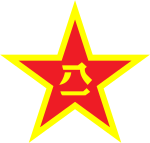| Chinese People's Liberation Army | |||||||||||||||||||||||
|---|---|---|---|---|---|---|---|---|---|---|---|---|---|---|---|---|---|---|---|---|---|---|---|
| Simplified Chinese | 中国人民解放军 | ||||||||||||||||||||||
| Traditional Chinese | 中國人民解放軍 | ||||||||||||||||||||||
| Literal meaning | "China People Liberation Army" | ||||||||||||||||||||||
| |||||||||||||||||||||||
| People's Liberation Army |
|---|
 |
| Executive departments |
| Staff |
| Services |
| Arms |
| Domestic troops |
| Special operations force |
| Military districts |
| History of the Chinese military |
| Military ranks of China |
 |
|---|
|
|
The People's Liberation Army (PLA) is the military of the Chinese Communist Party (CCP) and the People's Republic of China. It consists of four services—Ground Force, Navy, Air Force, and Rocket Force—and four arms—Aerospace Force, Cyberspace Force, Information Support Force, and Joint Logistics Support Force. It is led by the Central Military Commission (CMC) with its chairman as commander-in-chief.
The PLA can trace its origins during the Republican Era to the left-wing units of the National Revolutionary Army (NRA) of the Kuomintang (KMT) when they broke away in 1927 in an uprising against the nationalist government as the Chinese Red Army, before being reintegrated into the NRA as units of New Fourth Army and Eighth Route Army during the Second Sino-Japanese War. The two NRA communist units were reconstituted as the PLA in 1947.[9] Since 1949, the PLA has used nine different military strategies, which it calls "strategic guidelines". The most important came in 1956, 1980, and 1993.[10] Politically, the PLA and the paramilitary People's Armed Police (PAP) have the largest delegation in the National People's Congress (NPC); the joint delegation currently has 281 deputies—over 9% of the total—all of whom are CCP members.
The PLA is not a traditional nation-state military. It is a part, and the armed wing, of the CCP and controlled by the party, not by the state. The PLA's primary mission is the defense of the party and its interests. The PLA is the guarantor of the party's survival and rule, and the party prioritizes maintaining control and the loyalty of the PLA. According to Chinese law, the party has leadership over the armed forces and the CMC exercises supreme military command; the party and state CMCs are practically a single body by membership. Since 1989, the CCP general secretary has also held been the CMC Chairman; this grants significant political power as the only member of the Politburo Standing Committee with direct responsibilities for the armed forces. The Ministry of National Defense has no command authority; it is the PLA's interface with state and foreign entities and insulates the PLA from external influence.
Today, the majority of military units around the country are assigned to one of five theatre commands by geographical location. The PLA is the world's largest military force (not including paramilitary or reserve forces) and has the second largest defence budget in the world. China's military expenditure was US$296 billion in 2023, accounting for 12 percent of the world's defence expenditures. It is also one of the fastest modernizing militaries in the world, and has been termed as a potential military superpower, with significant regional defence and rising global power projection capabilities.[11][12]: 259
In addition to wartime arrangements, the PLA is also involved in the peacetime operations of other components of the armed forces. This is particularly visible in maritime territorial disputes where the navy is heavily involved in the planning, coordination and execution of operations by the PAP's China Coast Guard.[13]
- ^ "【延安记忆】"中国人民解放军"称谓由此开始". 1 August 2020. Archived from the original on 22 August 2020. Retrieved 22 August 2020.
- ^ "1947年10月10日,《中国人民解放军宣言》发布". 中国军网. 10 October 2017. Archived from the original on 22 August 2020. Retrieved 22 August 2020.
- ^ "中国共产党领导的红军改编为八路军的背景和改编情况 – 太行英雄网". Archived from the original on 7 January 2022. Retrieved 7 January 2022.
- ^ Cite error: The named reference
:4was invoked but never defined (see the help page). - ^ a b The International Institute for Strategic Studies 2022, p. 255.
- ^ a b "Trends in Military Expenditure 2023" (PDF). Stockholm International Peace Research Institute. April 2024. Retrieved 22 April 2024.
- ^ Xue, Maryann (4 July 2021). "China's arms trade: which countries does it buy from and sell to?". South China Morning Post. Archived from the original on 26 May 2022. Retrieved 26 May 2022.
- ^ a b "TIV of arms imports/exports from China, 2010–2021". Stockholm International Peace Research Institute. 7 February 2022. Archived from the original on 21 June 2023. Retrieved 26 January 2023.
- ^ Cite error: The named reference
Benton-1999was invoked but never defined (see the help page). - ^ Fravel, M. Taylor (2019). Active Defense: China's Military Strategy since 1949. Vol. 2. Princeton University Press. doi:10.2307/j.ctv941tzj. ISBN 978-0-691-18559-0. JSTOR j.ctv941tzj. S2CID 159282413.
- ^ "Global military spending remains high at $1.7 trillion". Stockholm International Peace Research Institute. 2 May 2018. Archived from the original on 27 May 2018. Retrieved 13 October 2018.
- ^ International Institute for Strategic Studies (2020). The Military Balance. London: Routledge. doi:10.1080/04597222.2020.1707967. ISBN 978-0367466398.
- ^ Saunders et al. 2019, p. 148.

